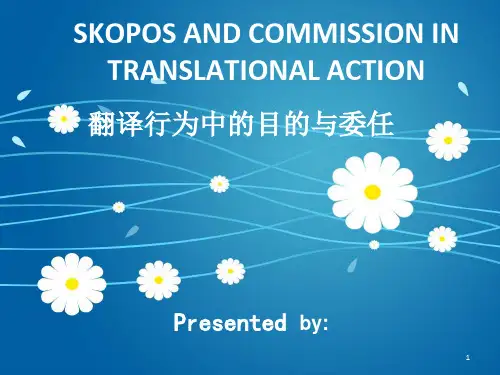实用翻译教程课件An Applied Theory of Translation.ppt
- 格式:ppt
- 大小:294.50 KB
- 文档页数:95
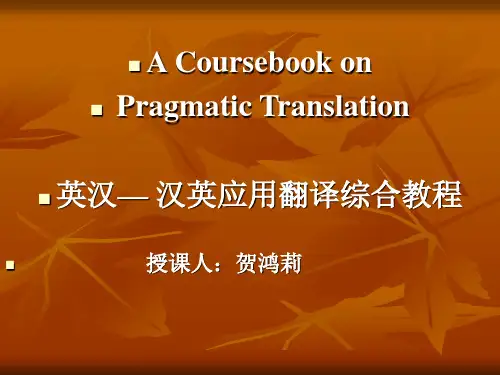
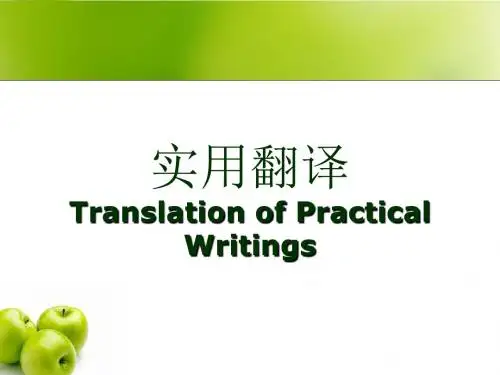
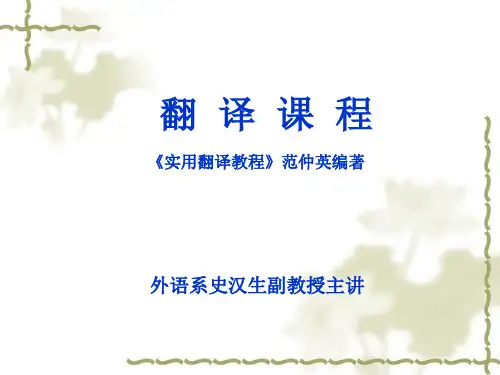
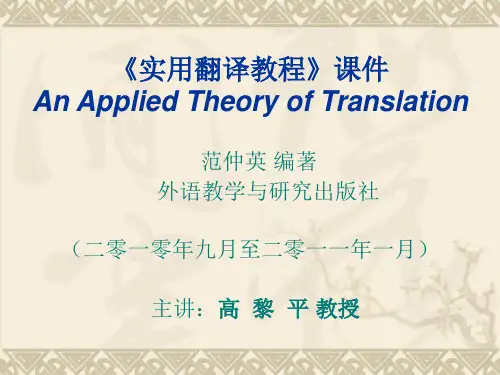
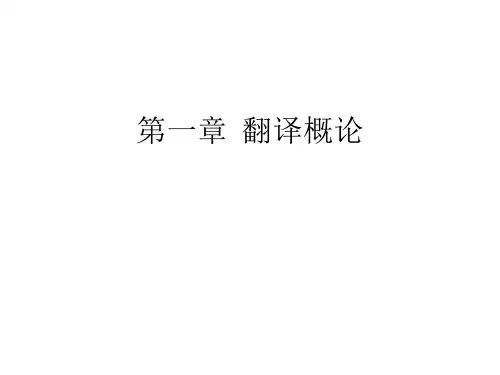
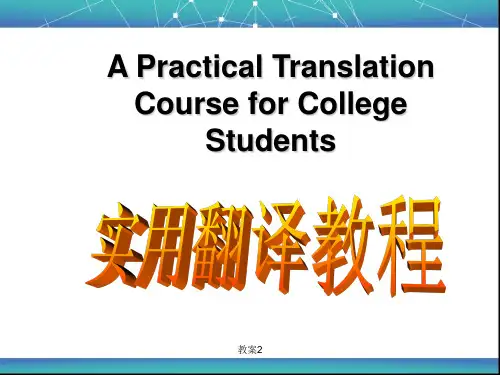
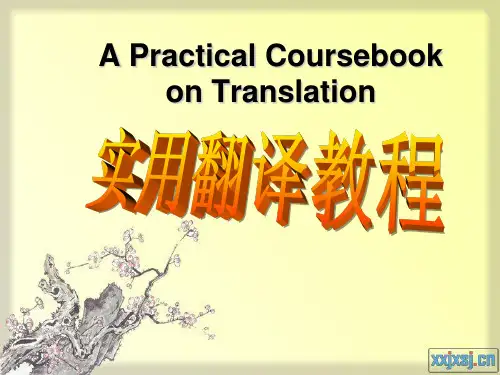
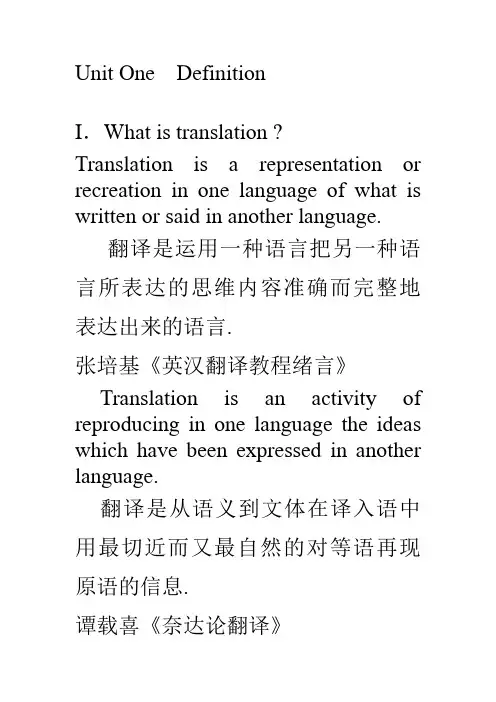
Unit One DefinitionI.What is translation ?Translation is a representation or recreation in one language of what is written or said in another language.翻译是运用一种语言把另一种语言所表达的思维内容准确而完整地表达出来的语言.张培基《英汉翻译教程绪言》Translation is an activity of reproducing in one language the ideas which have been expressed in another language.翻译是从语义到文体在译入语中用最切近而又最自然的对等语再现原语的信息.谭载喜《奈达论翻译》Translating consists in reproducing in the receptor language the closest natural equivalent of the source language message, first in terms of meaning, and secondly in terms of style.Eugene A. Nida and Taber The Theory and Practice of Translation翻译就是译入语复制出原语信息最接近的自然等值体, 首先就意义而言,其次就风格而言.II. Classification1.从译出语(出发语, source language)和译入语(归宿语target或receptor language)的角度分为: 1)本族语译外语2)外语译本族语2.从语言符号(semiology)的角度分为: 1)语内翻译(intralingualtranslation)2)语际翻译(interlingual translation)3)符际翻译(intersemiotic translation) 3. 从翻译的手段分为: 口译, 笔译和机器翻译4.从翻译的题材分为: 普通型翻译,专业性翻译, 文学翻译5.从翻译的方式分为: 全译(full-text), 摘译(abridged)和编译(adapted)III. Brief historyTranslation practice in China has a long history of about 4 thousand years. The character “译” appeared as early as about 4 thousand years ago. In Zhou Dynasty, in the Book of Rite such sentences have been found:五方之民, 言语不通, 嗜欲不同, 达其志, 通其欲, 东方曰“寄”, 南方曰“象”, 西方曰“狄”, 北方曰“译”重舌, 通事, 象寄之才第一次翻译高潮(flourishing period) Buddhist Scripture 安世高, 支娄加谶, 支亮, 支谦, 竺法护, 道安,鸠摩罗什译界第一宗匠鸠摩罗什, 玄奘, 真谛, 我国佛教三大翻译家(three giants in translating Buddhist Scripture)第二次翻译高潮意大利人利玛窦(Matteo Ricci 1552--1610) 徐光启(1562--1633) 欧几里得(Euclid’s)《几何原本》, 《测量法仪》第三次翻译高潮严复(1853—1921)林纾(1852—1924)第四次翻译高潮Unit Two. Theory, Principle and Criteria of Translation第一部有文字记载的翻译理论著作三国, 支谦《法句经序》近代严复的“信,达,雅”三个字分散见于此部著作“因循本旨,不加文饰”(following the original meaning without any embroidery)东晋, 道安“案本而传,不令有损言游字”(preaching according to the original without any deduction or addition) 直译派鸠摩罗什“只要能存本旨就不妨依实出华”(elegance based on the original), 意译派竺法护直译“天见人, 人见天”鸠摩罗什“人天交接, 两得相见”唐代玄奘“既须求真, 又须喻俗”-----忠实(faithfulness), 通顺(smoothness)近代严复《天演论译例言》(1898)信: faithfulness, 达: expressiveness 雅: elegance马建忠善译鲁迅凡是翻译, 必须兼顾着两面, 一当然力求其易解, 一则保存原作的风姿(A translator must strive on the one hand, to make his translation easy for the reader to understand, and on the other, to keep the charm and style of the author )宁信而不顺(rather being faithful in thought than smooth in language)傅雷神似(spiritual conformity, expression resemblance) “所求不在形似而在神似”钱钟书化, 化境(sublimed adaptation, transfiguration)外国著名的翻译标准论述有:十八世纪, 英国, 亚力山大弗雷賽泰特勒(Alexander Fraser Tytler 1747—1814) 《论翻译的原则》(1792)1) A translation should give acomplete transcript of the ideas of the original work. (译文应完全复写出原作的思想)2)The style and manner of writingshould be of the same character as that of the original. (译文的风格和笔调应与原文的性质相同)3) A translation should have all theease of the original composition.(译文应和原作同样流畅)刘重德信, 达, 切, 信, 达, 贴(closeness)标准, 原则可总结为: 一.忠实, 二.通顺。

